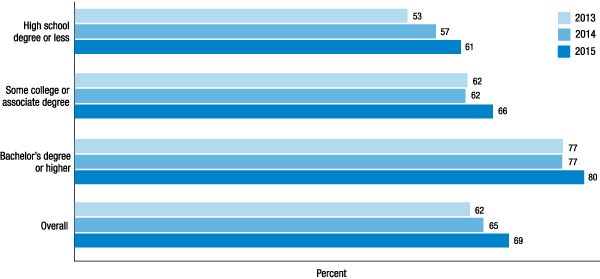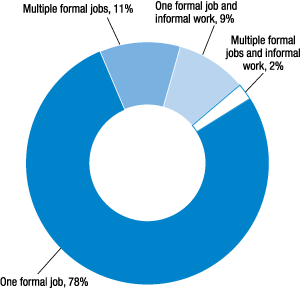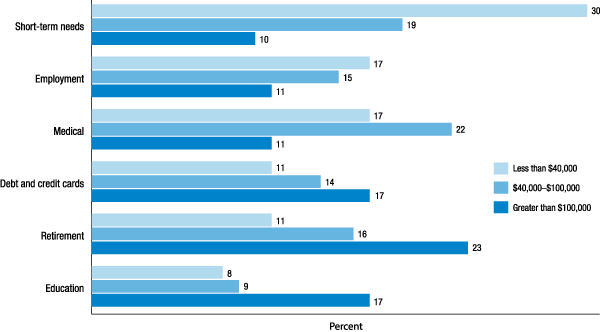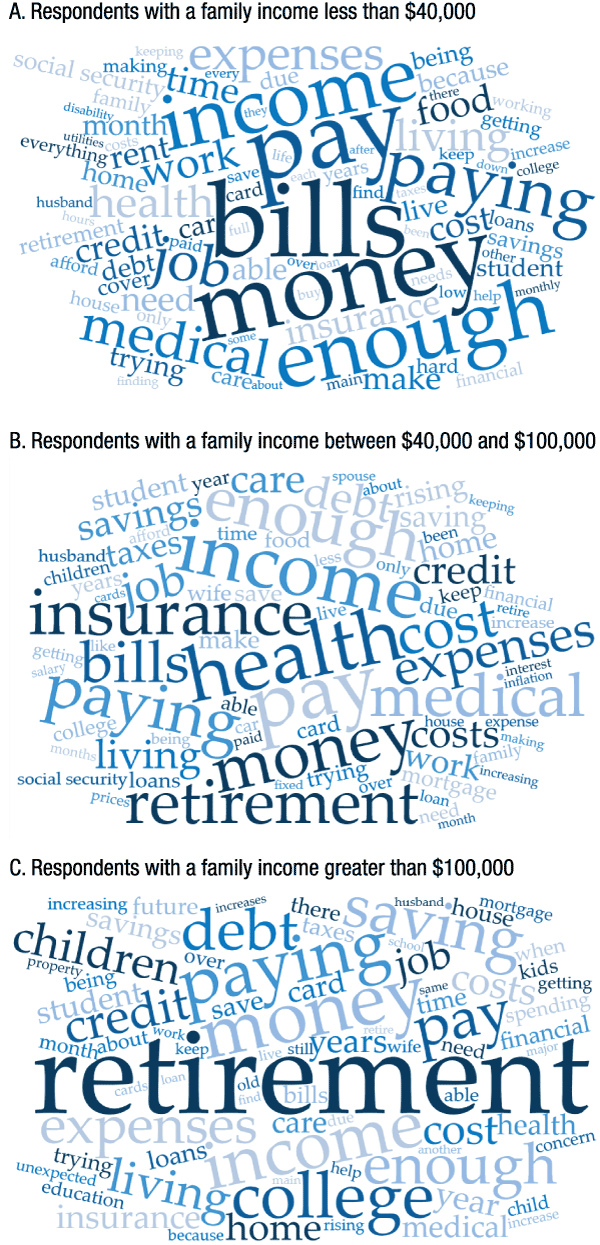Report on the Economic Well-Being of U.S. Households in 2015
- Preface
- Executive Summary
- Introduction
- Overall Economic Well-Being
- Income and Savings
- Economic Preparedness and Emergency Savings
Overall Economic Well-Being
Respondents to the survey are asked a range of questions relating to their financial well-being, including how they are currently faring overall, the change in their economic well-being in recent years, and their expectations for the future. The 2015 survey finds that individuals and their families showed continued improvement in their economic well-being relative to 2013 and 2014. Nevertheless, many adults continue to exhibit signs of struggling in some aspects of their financial lives. This is manifested by the nearly one-third of respondents who say that they are struggling to get by or are just getting by, as well as by the many lower-income individuals who indicate that their biggest financial concerns involve simply meeting their short-term needs. Additionally, optimism about future income growth in the coming year has tempered throughout the distribution relative to that seen in the 2014 survey.
Current Economic Circumstances
In order to assess self-perceptions of financial well-being, the survey asks respondents how they are currently managing financially. Overall well-being of individuals and their families continued a mild path of improvement in 2015. Twenty-eight percent of respondents in the 2015 survey report that they are "living comfortably" and 41 percent report that they are "doing okay." The combined 69 percent of respondents who are either living comfortably or doing okay is up a statistically significant 4 percentage points from that seen in 2014 and up just over 6 percentage points from that seen in 2013.5
These improvements in self-assessed well-being have occurred across the socioeconomic spectrum. Since current income and self-assessed financial well-being are likely codetermined by recent financial circumstances, the relationship between well-being trends and socioeconomic characteristics is considered by comparing trends in well-being for those with different levels of education. Respondents with a bachelor's degree or higher are by far the most likely to report that they are at least doing okay financially, with four out of five such individuals reporting they are doing okay or living comfortably. However, the likelihood of reporting this level of overall well-being has increased since 2013 for respondents with all levels of education (figure 1).

Note: Here and in subsequent figures and tables, percents may not sum to 100 due to rounding and question non-response.
Nevertheless, while the self-assessed financial well-being of adults shows continued improvement in 2015, just under one-third of respondents still report that they are either "finding it difficult to get by" (9 percent) or are "just getting by" (22 percent) financially. This represents approximately 76 million adults who are struggling to some degree to get by. The likelihood of experiencing this level of financial stress is also not uniform in the population. In particular, single parents, racial and ethnic minorities, and respondents with lower levels of income or education are all more likely to report that they were having some level of difficulty getting by financially (table 2).6
| Characteristic | Finding it difficult to get by | Just getting by | Doing okay |
Living comfortably |
|---|---|---|---|---|
| Family income | ||||
| Less than $40,000 | 17.7 | 31.6 | 38.5 | 12.1 |
| $40,000-$100,000 | 4.4 | 19.4 | 47.3 | 28.8 |
| Greater than $100,000 | 1.8 | 7.9 | 36.6 | 53.7 |
| Race/ethnicity | ||||
| White, non-Hispanic | 8.5 | 20.3 | 40.7 | 30.3 |
| Black, non-Hispanic | 10.3 | 28.3 | 40.9 | 20.4 |
| Hispanic | 12.3 | 24.7 | 42.6 | 20.5 |
| Education | ||||
| High school degree or less | 12.9 | 25.9 | 41.2 | 19.8 |
| Some college or associate degree | 8.9 | 25.1 | 42.1 | 23.9 |
| Bachelor's degree or more | 5.7 | 13.8 | 39.5 | 40.9 |
| Marital and parental status | ||||
| Unmarried, no children under 18 | 12.1 | 25.0 | 41.7 | 21.0 |
| Married, no children under 18 | 5.6 | 15.3 | 42.5 | 36.7 |
| Unmarried, children under 18 | 18.7 | 34.3 | 33.7 | 13.3 |
| Married, children under 18 | 6.9 | 22.2 | 39.9 | 31.0 |
| Overall | 9.4 | 22.0 | 41.0 | 27.6 |
The survey also tracks overall economic well-being through the alternate approach of asking respondents whether they are better off now financially than they were 12 months ago. Measuring well-being in this way is important for tracking individuals' economic trajectories, as some respondents may feel that their well-being has improved or declined but has not done so sufficiently to shift responses to the question on their contemporaneous well-being. Additionally, without asking respondents directly about the trajectory in their well-being, potential declines in well-being for those who were already finding it difficult to get by would be overlooked, which can then yield an unbalanced picture of economic progress (see box 1).
When asked how they are faring financially compared to a year earlier, individuals are more likely to say that their financial well-being improved in the past year than to say that it declined. However, consistent with results from the 2014 survey, the responses to this question provide some evidence that economic advancement continues to be experienced to a greater degree for respondents in higher socioeconomic circumstances. Among those with only a high-school degree or less, respondents are just 1 percentage point more likely to report that they are better off than they were a year earlier than to say that they are worse off. Hence, the net-positive assessment of economic trajectories that is seen for the overall population is almost completely driven by respondents with at least some college education (table 3).
| Education level | Somewhat or much worse off | The same | Somewhat or much better off | Better off minus worse off |
|---|---|---|---|---|
| High school degree or less | 21.3 | 56.1 | 22.4 | 1.1 |
| Some college or associate degree | 18.9 | 51.5 | 29.2 | 10.4 |
| Bachelor's degree or more | 14.7 | 54.0 | 31.1 | 16.4 |
| Overall | 18.5 | 54.0 | 27.3 | 8.8 |
Box 1. Tracking Well-Being over Time among Re-Interviewed 2014 Survey Respondents
Somewhat different pictures of the inclusiveness of recent economic improvements emerge in the survey based on the responses to the two questions "Overall, which one of the following best describes how well you are managing financially these days?" and "Compared to 12 months ago, would you say that you are better off, the same, or worse off financially?" Tracking responses among all respondents to the former question over time in the cross-sectional data, it appears that individuals across the socioeconomic spectrum improved at relatively even rates from 2014 to 2015. However, based on all responses to the latter question, it appears that improvements over the previous year were largely confined to those of higher socioeconomic status with greater levels of education.
The panel of re-interviewed respondents can offer insights into these divergent observations. The 2015 survey selected 2,117 respondents from the 2014 survey to be re-interviewed about their financial experiences so that the well-being of these respondents can be linked over time. It is therefore possible to observe information over time on the respondents' contemporaneous well-being and link this information to how individuals feel that their well-being has changed over the past 12 months.
Among this group of re-interviewed respondents, those who were well off in 2014 are the most likely to say in the 2015 survey that they are better off than they were a year earlier. Thirty-five percent of re-interviewed respondents who were already living comfortably in 2014 indicate that they are even better off than they had been in the previous year. In contrast, only 18 percent of the disproportionately less-educated individuals who were finding it difficult to get by in 2014 report that they are somewhat or much better off in 2015. Nearly half of those who had been finding it difficult in 2014 now say that they are actually worse off than they had been a year earlier (figure A).
By tracking the responses of re-interviewed respondents over time, it is clear that while more individuals across the socioeconomic spectrum now feel that they are doing okay than was the case a year earlier (as was observed in the main text of this report), many respondents who were struggling in 2014 feel that, if anything, their well-being has deteriorated even further during the past year. However, given that these respondents were already reporting that their well-being was at the lower tail of the contemporaneous self-assessed well-being scale, this further deterioration in their financial circumstances can only be observed by asking how their well-being has changed over time and not just by asking how they are faring economically today.
Figure A. Self-assessed trajectory in financial well-being in 2015 for individuals with different levels of contemporaneous well-being in 2014

Employment, Multiple Jobs, and Informal Work
Closely related to overall economic well-being is one's employment status. In the survey, 57 percent of respondents report being employed, while 19 percent are retired, 7 percent are disabled and not working, 6 percent are homemakers, 4 percent are students, and 7 percent are not employed (including both those looking and not looking for work) or on temporary layoff. The employment-population ratio in the SHED is comparable to that reported by the Bureau of Labor Statistics using Current Population Survey data.7
Among the respondents who are employed, the SHED attempts to gauge the extent to which individuals who have a job desire additional employment to supplement their income. It does so by asking non-self-employed respondents whether they would prefer to work more, less, or the same number of hours that they currently work at their current hourly wage from their main job.8 Thirty-five percent of these respondents indicate that they would prefer to work more hours at their current wage, which is nearly identical to the 36 percent with this preference in the 2014 survey. Lower-income respondents, non-Hispanic blacks, Hispanics, younger respondents, and those with less education are the most likely to say that they would prefer to work more hours than they currently do (table 4).
| Characteristic | Work fewer hours | Work the same number of hours |
Work more hours |
|---|---|---|---|
| Family income | |||
| Less than $40,000 | 5.0 | 46.7 | 47.4 |
| $40,000-$100,000 | 6.7 | 60.4 | 32.5 |
| Greater than $100,000 | 9.6 | 65.6 | 24.6 |
| Race/ethnicity | |||
| White, non-Hispanic | 8.2 | 61.0 | 30.4 |
| Black, non-Hispanic | 6.0 | 49.5 | 43.3 |
| Hispanic | 3.5 | 53.1 | 42.9 |
| Age | |||
| 18-29 | 4.4 | 49.6 | 45.5 |
| 30-44 | 6.7 | 58.0 | 34.8 |
| 45-59 | 7.3 | 60.4 | 32.0 |
| 60+ | 12.0 | 64.6 | 22.1 |
| Education | |||
| High school degree or less | 6.7 | 55.4 | 37.6 |
| Some college or associate degree | 6.5 | 54.6 | 37.9 |
| Bachelor's degree or more | 7.6 | 61.6 | 30.6 |
| Overall | 6.9 | 57.5 | 35.1 |
Note: Among respondents who are currently employed for someone else or who work as a consultant or contractor.
One way in which some respondents may supplement their income is by taking on multiple jobs or part-time work. Another is through work performed outside of a formal employment situation, including activities such as selling handcrafted goods, freelance work for a company as an independent contractor, or providing services for others independently. Over one-fifth of employed adults indicate that they are either working multiple jobs, that they are doing informal work for pay, or that they are both working multiple jobs and doing informal work for pay
(figure 2).9 Among respondents who report no formal employment, the survey similarly finds a robust
level of informal work. Twenty-seven percent of non-student, non-retired respondents who do not have formal employment report that they are doing some form of work for pay that is not through a formal job.

Note: Among non-student, non-retired respondents who report that they are employed in at least one formal job. Respondents are prompted in the question that work for pay that is not through a formal job "may include activities like selling items you make at flea markets or online; freelance work through companies like Uber, Care.com, or Airbnb; or providing services for others like paid child care or yard work."
There is evidence that young adults are more likely to be taking on informal work than those in older cohorts. Approximately 20 percent of non-students under age 30 report engaging in some form of informal work, whereas 15 percent of those ages 30 to 44 and only about 11 percent of those age 45 or older are doing so. While not all differences by education and income group are statistically significant, there is also some evidence that those most likely to engage in such activities are individuals who have lower incomes but higher levels of education (table 5).
| Education level | Less than $40,000 |
$40,000- $100,000 | Greater than $100,000 |
|---|---|---|---|
| High school degree or less | 15.4 | 11.0 | 6.1 |
| Some college or associate degree | 18.2 | 12.7 | 10.6 |
| Bachelor's degree or more | 21.1 | 18.3 | 12.7 |
Note: Excludes students, retirees, and individuals reporting that they are out of work due to a disability.
Self-Assessed Financial Challenges
The survey also explores the well-being of respondents by posing an open-ended question that inquires about any financial challenges that they currently face. Respondents were asked either to check a box indicating that they face no financial challenges or provide a response to the question, "In a couple of words (150 character max), please describe the main financial challenges or concerns facing you or your family?" Forty-nine percent of respondents (unweighted) checked the box, while most of the remaining 51 percent of respondents provided some response to the open-ended question.10 The content in these responses was then coded based on terms included in the responses in order to identify broad themes under which the respondents' financial challenges can be grouped.11
While there is no statistically significant difference by income in the likelihood of respondents saying that they faced no financial challenges, the types of challenges differ greatly by income. Short-term challenges, such as rent, food, gas, utilities, and other bills, are reported as a financial challenge most frequently by respondents whose family income is under $40,000 per year. Similarly, while a number of respondents in all income groups discuss employment concerns, these too are most common among lower-income respondents. Health care concerns are most common among lower- and middle-income respondents. In contrast, concerns relating to retirement or education are each most prevalent among respondents in the upper-income group (figure 3).12
Figure 3. Areas of concern cited in open-ended question on self-reported financial challenges (by family income)

Note: Among respondents who report any concerns. Results for the open-ended text response question are unweighted.
The difference in the array of financial concerns can be seen visually in the word clouds in figure 4 (on page 13). Each word cloud includes the 75 most frequently observed words in the description of individuals' challenges, with the size of the word reflecting its frequency. The word clouds closely mirror the observations regarding major challenges by income group that could be ascertained from figure 3. Among lower-income respondents, "bills" is the most commonly reported word. In contrast, "retirement" is the most dominant word to appear in the self-reported financial challenges of higher-income respondents. This provides some additional evidence that higher-income individuals are concerned about their long-run financial health, whereas those lower in the income distribution may be unable to focus on these long-run concerns as they struggle to meet their short-term financial obligations.
Figure 4. Concerns cited in open-ended question on self-reported financial challenges (by family income)

Note: Among respondents who report any concerns. Word clouds include the 75 most common words referenced, plus ties. The larger the word, the more frequently it was cited by respondents. Common stop words are those that do not provide information about financial challenges, such as "the" and "are." Results for the open-ended text response question are unweighted.
Financial Expectations for 2016
While the survey primarily focuses on the current financial situation of respondents and how it has changed over the prior 12 months, it also asks individuals how they expect their financial situation to change in the coming year. Here, the trend in survey results over time is less positive than that seen for the current situation. Twenty-three percent of respondents expect their income to be higher in the next 12 months (through October 2016) than it had been in the previous 12 months. This is 6 percentage points lower than was seen when the same question was asked in the 2014 survey.13
As was the case in the 2014 survey, optimism about future income growth is correlated with the age of respondents. Younger individuals are the most optimistic about their income trajectory in the near term, with 37 percent of those under age 30 believing their income will increase in the year after the survey, and 28 percent of those between ages 30 and 44 expecting income growth over the same period. Expectations about income growth then decline with age (table 6). The low 10 percent of respondents age 60 or older who expect their income to increase in the coming year may partially reflect the lack of a cost of living increase for those on Social Security in 2016--which was announced approximately two weeks before the survey went into the field.
| Characteristic | Lower | About the same | Higher |
|---|---|---|---|
| Family income | |||
| Less than $40,000 | 9.1 | 69.6 | 19.9 |
| $40,000-$100,000 | 7.7 | 69.9 | 22.0 |
| Greater than $100,000 | 5.9 | 63.6 | 30.5 |
| Age | |||
| 18-29 | 8.4 | 53.8 | 36.9 |
| 30-44 | 6.4 | 64.4 | 28.2 |
| 45-59 | 8.1 | 70.9 | 20.3 |
| 60+ | 8.9 | 80.8 | 9.8 |
| Overall | 7.9 | 68.3 | 23.0 |
Also consistent with the prior year's survey, those with lower incomes are the least optimistic about rising incomes going forward. Among those in the lowest income group, 20 percent of respondents expect that their income will be higher in the coming year. This compares to just over 30 percent of the respondents in the highest income group who expect rising incomes.
References
5. References to statistical significance throughout this report are based on the 90 percent confidence level. Results for 2013 may deviate slightly from those presented in the Report on the Economic Well-Being of U.S Households in 2013. This reflects a change in weighting criteria in 2014 that included income brackets when weighting respondents to match the U.S. population. To ensure that any changes since 2013 reflect actual trends, rather than methodological differences, the 2013 data were re-weighted using the same weighting criteria as subsequent surveys for the purposes of comparisons within this report. Return to text
6. As is discussed in additional detail in the "Income and Savings" section of this report, income is measured in this report as the income of the respondent and his or her spouse or partner. This may differ from the total income received by all members of the household. Return to text
7. In addition to the 57 percent of respondents who report being employed, about 2 percent of respondents indicate that they are primarily a student but also have a full-time or part-time job, and about 2 percent indicate that they are primarily retired but also have a full-time or part-time job. Looking at respondents ages 20 and older in this survey, 60 percent report having a job of any kind. This compares to a 61.5 percent employment-population ratio reported by the Bureau of Labor Statistics for this age group in October 2015 (see www.bls.gov/news.release/empsit.t01.htm). Return to text
8. The question specifically asks respondents about their preference for more work at their current hourly wage in order to assess pent-up demand for more work, rather than demand that may exist for better work at a higher salary. Return to text
9. Informal work is considered work for pay that the respondent reports performing that is not through a formal job. Retirees, students, and individuals who are out of work due to a disability were not asked about multiple jobs or informal work, and are excluded from the calculations in this section. Return to text
10. Five percent of respondents provided no response to the open-ended question and did not check the box indicating that they had no challenges. This group may include some people who had no concerns and others who simply chose not to provide an answer. Return to text
11. Sentences in which the respondent mentions any of the terms retire, pension, old age, Medicare, SSI, IRA, 401(k), or Social Security were grouped into the "retirement" theme; those that mentioned student loan, college, school, education, tuition, degree, university, or student were grouped into the "education" theme"; those mentioning job, employ, laid off, part-time, hours, full-time, overtime, cutback, skills, salary, wage, or work were grouped into the "jobs" theme; those mentioning food, gas, bills, utilities, rent, or mortgage, or car were grouped into the "short-term concerns" theme; those mentioning medical, medicine, health, insurance, Obamacare, Medicaid, and Medicare were grouped into the "medical" theme; and those mentioning credit card, loan, debt, or owe were grouped into the "debt" theme. Responses can be included in multiple themes, as the categories are not mutually exclusive. All results based on the text analysis of responses are unweighted. Return to text
12. Looking at concerns about retirement for individuals with different income levels who are within age bands, it remains true that higher-income individuals are more likely to mention concerns about retirement and less likely to mention concerns about short-term challenges. Therefore, while it is true that the greater concerns about retirement among higher-income individuals in part reflects the concerns of older individuals who are both closer to retirement and have higher income, income clearly plays an important role even independent of age. Return to text
13. Since the survey was fielded in October/November of 2015, questions regarding the coming 12 months reflect respondents' opinions on their incomes through approximately October/November 2016. Responses about the previous year should reflect the period from approximately November/December 2014 through October/November 2015. Return to text
